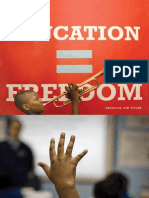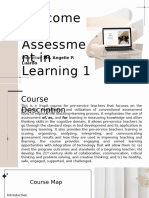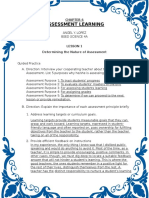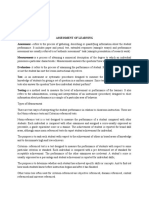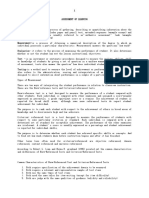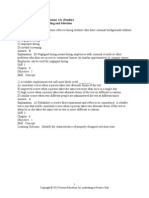Use Process When
Uploaded by
AndanteUse Process When
Uploaded by
AndantecLESSON 8
The following are the BENEFITS performance-based assessment offers:
1. Assess complex learning outcomes not measured by pen-and-paper tests
2. Assess both process and product
3. Communicate instructional goals that relate to real world context
4. Involve the students in the process of assessing their own growth
5. Recognize that students can express what they know and can do in different ways
6. Enhance the professional skills of teachers through collaboration with other teachers
7. Engage students and boost their interest and motivation
Below on the other hand are the LIMITATIONS of performance-based assessments:
1. Time consuming both in constructing, administrating and assessing
2. Subjectivity of scoring
3. Discouraging to less abled students
LESSON 9
Use process when:
1. There is no product
2. The process is orderly and directly observable
3. Correct procedures/steps are crucial
4. Analysis of procedural steps can help in improving the product
5. Learning is at the early stages
Use product when:
1. Different procedures can be used to produce the same product
2. Procedures are not available for observation
3. Procedures have been mastered already
4. Products have qualities that can be identified and judged
Mainly, there are four general STEPS in order to craft your own performance-based assessment. Those are:
1. Define the purpose of the assessment
2. Determine the skills, learning outcomes and taxonomy level
3. Design and develop activity or performance task
4. Define the performance criteria
Below are the different SUGGESTIONS in developing performance tasks and the ways of improving scores (Gronlund, et al., 2009)
1. Focus on learning outcomes that require complex cognitive skills and student performances
2. Select or develop tasks that represents both content and skills that are central to important learning outcomes
3. Minimize the dependence of task performance on skills that are relevant to intended purpose of the assessment task
4. Provide the necessary scaffolding for the students to be able to understand the task and what is expected from their performance
5. Construct task directions so that the students’ task is clearly indicated
6. Clearly communicate performance expectations in terms of the scoring rubrics by which the performance will be judged
McMillan (2007) CHECKLIST for Writing a Good Performance Task
1. Essential content and skills targets are integrated
2. Multiple targets are included
3. The task is authentic
4. The task is teachable
5. The task is feasible
6. Multiple paths or solutions are possible
7. The nature of the task is clear
8. The task is challenging and stimulating
9. Criteria for scoring is included*
10. Constraints for completing the task is included
LESSON10
Basically, rubrics are composed of the title, the dimensions, scale, dimensions/criteria and descriptions of dimensions.
Stevens and Levi (2005) enumerated the STEPS in developing rubric.
1. Copy the task description form the designed performance task and place appropriate title of the matrix
2. Set up the scale to be used. It describes how well or poorly any given task has been performed and determine
to what degree the students have met a certain criterion. Below are some of the commonly used labels for
scaling compiled by Huba and Freed (2000)
Sophisticated, competent, partly competent, not yet competent
Exemplary, proficient, marginal, unacceptable
Advanced, intermediate high, intermediate, novice
Distinguished, proficient, intermediate, novice
Accomplished, average, developing, beginning
3. Identify the set of criteria or dimensions which will serve as basis for evaluating student output or performance.
The dimension or criteria of rubrics lay out the parts and how tasks are divided into its important components
as basis for scoring the student.
4. Specify the level of performance by providing necessary descriptions. Description of dimensions allows both
the teachers and the students to identify the level of expectation and what dimensions must be given an emphasis.
LESOON 12
Level 1. Receiving (Attention)
It is concerned with getting, holding and directing student’s attention. Attention concerns the student’s willingness to attend
to a classroom activity and being directed by the teacher.
Example: Listening to the idea of others with respect
Verbs: ask, choose, describe, follow, give, hold, identify, locate, name, point to, select, sit, erect, reply and use
Level 2. Responding (Interest)
It now involves the active participation of the learners by showing interest on what they are doing. Interest can be shown by
completing the assigned work, active participation in class discussion, volunteering for tasks, showing interest in the subject
Example: Participating in class discussion actively
Verbs: answer, assist, aid, comply, conform, discuss, greet, help, label, perform, practice, present, read, recite, report, select, tell and write
Level 3. Valuing (Preference/Appreciation)
Refers to the willingness to be perceived by others as valuing certain ideas, materials, phenomenon or behavior.
Preference or appreciation can be shown in general reaction to a series of questions that the teacher gets from the students.
Example: Demonstrating belief in the democratic process; showing the ability to solve problem
Verbs: complete, demonstrate, differentiate, explain, follow, form, initiate, invite, join, justify,
propose, read, report, select, share, study and work
Level 4. Organization (Philosophy of life)
It is concerned with the development of philosophy of life by bringing out the values of the students together to form a value.
Philosophy of life can be shown by accepting responsibility for his behavior, understanding and accepting own strengths and weaknesses
Examples: Explaining the role of systematic planning in solving problems; prioritizing time
Verbs: adhere, alter, arrange, combine, compare, complete, defend, explain, formulate, generalize,
identify, integrate, modify, order organize, prepare, relate and synthesize
Level 5. Characterization by value (Lifestyle)
It is concerned with how the students are consistently with values internalized. Lifestyle can be illustrated by demonstrating
Example: Showing self-reliance when working independently; valuing people for what they are not how they look like
Verbs: act, discriminate, display, influence, listen, modify, perform, practice, propose, qualify, question, revise, serve, solve and verify.
LESSON 13 Methods of Assessing Affective Domain
three feasible methods of assessing affective traits. Those are: a.) teacher observation; b.) student self-report; and, c.) peer ratings.
A. Teacher Observation
It is an essential tool for formative assessment. Teachers first determine in advance how specific behaviors relate to the target.
They provide clear definition of traits followed by listing of students behaviors and actions corresponding to positive and negative dimensions.
Now these enlisted behaviors on the table above provides the foundation in developing checklist, rating scales and guidelines.
The positive behaviors are called the approach behaviors while the negative ones are called avoidance behaviors. Approach behaviors are
so called because they are direct, frequent and intense contact. Meanwhile avoidance are less direct, less frequent and less intense contact.
After the list of behaviors has been developed, the teacher needs to decide whether informal or formal observation will be used.
1. Informal or unstructured observations are used to make summative judgement. Normally open-ended, no checklist
or rating scale is used during this type of observation, everything is just simply recorded (anecdotal).
2. Formal or structured observations as compared to the other one needs a lot more preparation. Checklist or rating scales
are to be made since it will be used to record observations. The form is generated from a list of positive and
In using teacher observation method to assess affect the following can be good guidelines
• Determine behaviors to be observed in advance
• Record students important data such as time, data and place
• Record both positive and negative behaviors
• Have as much observation as possible
• Avoid personal bias
• Record immediately upon observation
B. Student Self-Report
Another good way to determine students affect is by directly getting information from them through their own self perception.
The most common direct ways are having interview and survey.
1. Student Interview. It is similar to observation but here, there is an opportunity that teachers may have \
direct involvement with the students wherein teachers can probe and respond for better understanding.
Trust is an important factor here to be able to receive true reflections of the students.
2. Surveys and Questionnaires are similar to the structured teacher observation however instead of teachers
filling out the forms, students themselves are the ones answering. Surveys and questionnaires can be
of two formats, constructed-response and selected-response format. Constructed-response formats includes
simple statement or questions like essays. Selected-response format meanwhile can be of either among rating scale,
semantic differential scale or checklist.
The following are the guidelines in constructing assessment tools for student self-report:
• Keep measures focused on specific trait
• Establish trust with students
• Ensure anonymity if possible
• Keep questionnaires brief
• Keep item short and simple
• Write items in present tense
C. Peer Ratings
Among the three, this is the least common method. Because of the nature of learners, they do not always take this activity seriously
and most often they are subjective in conducting this peer rating. However, when taken seriously peer-rating can be very effective since
students are the ones who are interacting with each other for a longer period of time. The two methods of conducting ratings are:
1.) guess-who approach and 2.) socio-metric approach.
Reminder
In assessing affect the following should be considered:
1. Emotions and feelings change quickly most especially for young children and during early adolescence
2. Use varied approaches in measuring the same affective traits as possible.
3. Decide what type of data or results are needed, is it individual or group?
LESSON 14 Different Affective Assessment Tool
Affective domain encompasses behaviors in terms of attitudes, beliefs and feelings. There are various assessment tools that can be
used to measure affect.
A. Checklists
It is one of the effective formative assessment strategies to monitor specific skills, behaviors or dispositions of individual or group
of students. Checklists contain criteria that focus on the intended outcome or target.
Checklists are utilized to make a quick and easy way to observe and record behaviors for evaluation, provide information to teachers
if there are students who need help and provide formative assessment and help teachers monitor if students are on track.
B. Rating Scale
It helps students understand the learning target /outcomes and to focus students’ attention to performance. It gives specific feedback
to students of their strengths and weaknesses. There are two types of rating scales, numeric rating scale and descriptive graphic rating scale.
C. Likert Scale
It uses the five-point scale: Strongly Agree (SA), Agree (A), Undecided (U), Disagree (D) and Strongly Disagree (SD). It includes series of both
positive and negative opinions towards attitude object with atleast 10 items.
D. Semantic Differential Scale
It uses adjective pairs that provide anchors for feelings or beliefs that are opposite in direction and intensity. Students are to place a check
mark between the adjectives that describes their attitudes.
E. Sentence Completion
This affective assessment tool captures whatever comes to the mind of each student. The down side however is that it take more time
in scoring than the other traditional format.
LESSON 13 Methods of Assessing Affective Domain
three feasible methods of assessing affective traits. Those are: a.) teacher observation; b.) student self-report; and, c.) peer
ratings.
A. Teacher Observation
It is an essential tool for formative assessment. Teachers first determine in advance how specific behaviors relate to the target.
They provide clear definition of traits followed by listing of students behaviors and actions corresponding to positive and
negative dimensions.
Now these enlisted behaviors on the table above provides the foundation in developing checklist, rating scales and guidelines.
The positive behaviors are called the approach behaviors while the negative ones are called avoidance behaviors. Approach
behaviors are so called because they are direct, frequent and intense contact. Meanwhile avoidance are less direct, less frequent
and less intense contact.
After the list of behaviors has been developed, the teacher needs to decide whether informal or formal observation will be used.
1. Informal or unstructured observations are used to make summative judgement. Normally open-ended, no checklist or
rating scale is used during this type of observation, everything is just simply recorded (anecdotal).
2. Formal or structured observations as compared to the other one needs a lot more preparation. Checklist or rating scales
are to be made since it will be used to record observations. The form is generated from a list of positive and negative
behaviors to make it easy and convenient in recording.
In using teacher observation method to assess affect the following can be good guidelines
Determine behaviors to be observed in advance
Record students important data such as time, data and place
Record both positive and negative behaviors
Have as much observation as possible
Avoid personal bias
Record immediately upon observation
B. Student Self-Report
Another good way to determine students affect is by directly getting information from them through their own self perception.
The most common direct ways are having interview and survey.
1. Student Interview. It is similar to observation but here, there is an opportunity that teachers may have direct involvement
with the students wherein teachers can probe and respond for better understanding. Trust is an important factor here to be
able to receive true reflections of the students.
2. Surveys and Questionnaires are similar to the structured teacher observation however instead of teachers filling out the
forms, students themselves are the ones answering. Surveys and questionnaires can be of two formats, constructed-
response and selected-response format. Constructed-response formats includes simple statement or questions like
essays. Selected-response format meanwhile can be of either among rating scale, semantic differential scale or checklist.
The following are the guidelines in constructing assessment tools for student self-report:
Keep measures focused on specific trait
Establish trust with students
Ensure anonymity if possible
Keep questionnaires brief
Keep item short and simple
Write items in present tense
C. Peer Ratings
Among the three, this is the least common method. Because of the nature of learners, they do not always take this activity
seriously and most often they are subjective in conducting this peer rating. However, when taken seriously peer-rating can be
very effective since students are the ones who are interacting with each other for a longer period of time. The two methods of
conducting ratings are: 1.) guess-who approach and 2.) socio-metric approach.
Reminder
In assessing affect the following should be considered:
1. Emotions and feelings change quickly most especially for young children and during early adolescence
2. Use varied approaches in measuring the same affective traits as possible.
3. Decide what type of data or results are needed, is it individual or group?
LESSON 14 Different Affective Assessment Tool
Affective domain encompasses behaviors in terms of attitudes, beliefs and feelings. There are various assessment tools that can
be used to measure affect.
A. Checklists
It is one of the effective formative assessment strategies to monitor specific skills, behaviors or dispositions of individual or
group of students. Checklists contain criteria that focus on the intended outcome or target.
Checklists are utilized to make a quick and easy way to observe and record behaviors for evaluation, provide information to
teachers if there are students who need help and provide formative assessment and help teachers monitor if students are on track.
B. Rating Scale
It helps students understand the learning target /outcomes and to focus students’ attention to performance. It gives specific
feedback to students of their strengths and weaknesses. There are two types of rating scales, numeric rating scale and descriptive
graphic rating scale.
C. Likert Scale
It uses the five-point scale: Strongly Agree (SA), Agree (A), Undecided (U), Disagree (D) and Strongly Disagree (SD). It
includes series of both positive and negative opinions towards attitude object with atleast 10 items.
D. Semantic Differential Scale
It uses adjective pairs that provide anchors for feelings or beliefs that are opposite in direction and intensity. Students are to place
a check mark between the adjectives that describes their attitudes.
E. Sentence Completion
This affective assessment tool captures whatever comes to the mind of each student. The down side however is that it take more
time in scoring than the other traditional format.
You might also like
- IRM TI UK Bribery Guide A5 V6 Low Res ProofNo ratings yetIRM TI UK Bribery Guide A5 V6 Low Res Proof44 pages
- Advantages and Disadvantages of Types of Curriculum88% (8)Advantages and Disadvantages of Types of Curriculum12 pages
- A History of Democratic Education in American Public SchoolsNo ratings yetA History of Democratic Education in American Public Schools158 pages
- Assessment of Learning 1 Learning PacketsNo ratings yetAssessment of Learning 1 Learning Packets40 pages
- Assessmentinlearning1 Lessons1 41 240419065207 0bb1adc9100% (1)Assessmentinlearning1 Lessons1 41 240419065207 0bb1adc9165 pages
- Assessment 2 Chapter 3 Performance Based Assessment100% (1)Assessment 2 Chapter 3 Performance Based Assessment72 pages
- MODULE 2 Assessment Learning 2 Report-1No ratings yetMODULE 2 Assessment Learning 2 Report-111 pages
- in Foundations of Special and Inclusive EducNo ratings yetin Foundations of Special and Inclusive Educ26 pages
- Konsep Penilaian Autentik Proses Hasil Belajar Mata Pelajaran Bahasa InggrisNo ratings yetKonsep Penilaian Autentik Proses Hasil Belajar Mata Pelajaran Bahasa Inggris4 pages
- Learning Episode 5: Assessment Name of Observer Name of School School Address Name of Teacher Date(s) of Observation Time ObservedNo ratings yetLearning Episode 5: Assessment Name of Observer Name of School School Address Name of Teacher Date(s) of Observation Time Observed13 pages
- Notes On Educ 302 and 305 Assessment of LearningNo ratings yetNotes On Educ 302 and 305 Assessment of Learning28 pages
- Curriculum Evaluation and The Teacher PDFNo ratings yetCurriculum Evaluation and The Teacher PDF40 pages
- Chapter 4 School and Curriculum MagcamitReina Chiara G.No ratings yetChapter 4 School and Curriculum MagcamitReina Chiara G.7 pages
- Module 1 - Assessment of Learning (Basic Concepts in Assessment)No ratings yetModule 1 - Assessment of Learning (Basic Concepts in Assessment)9 pages
- ICE Prioritization Brainstorm PresentationNo ratings yetICE Prioritization Brainstorm Presentation112 pages
- MODULE 2 - ASSESSMENT OF LEARNING 1 COURSEPACKrevised100% (1)MODULE 2 - ASSESSMENT OF LEARNING 1 COURSEPACKrevised39 pages
- Module 4 lESSONS 1 and 2 - DESIGNING AND DEVELOPING ASSESSMENT TOOLSNo ratings yetModule 4 lESSONS 1 and 2 - DESIGNING AND DEVELOPING ASSESSMENT TOOLS37 pages
- Assessment in Learning II Module 1 For StudentsNo ratings yetAssessment in Learning II Module 1 For Students12 pages
- Ho 1 Finals Principles of High Quality AssessmentNo ratings yetHo 1 Finals Principles of High Quality Assessment27 pages
- How to Practice Before Exams: A Comprehensive Guide to Mastering Study Techniques, Time Management, and Stress Relief for Exam SuccessFrom EverandHow to Practice Before Exams: A Comprehensive Guide to Mastering Study Techniques, Time Management, and Stress Relief for Exam SuccessNo ratings yet
- Lesson 7 Communication Academic Purposes (2) NNo ratings yetLesson 7 Communication Academic Purposes (2) N6 pages
- Lesson 8.2 Communication For Work PurposesNo ratings yetLesson 8.2 Communication For Work Purposes5 pages
- Lesson 8.1 Communication For Work Purposes Part 1No ratings yetLesson 8.1 Communication For Work Purposes Part 19 pages
- Lesson 5 Evaluation of Texts in Multicultural ContextsNo ratings yetLesson 5 Evaluation of Texts in Multicultural Contexts6 pages
- SEMINAR Crafting Effective Lesson Plans Powerpoint PresentationNo ratings yetSEMINAR Crafting Effective Lesson Plans Powerpoint Presentation54 pages
- Cor Jesu College, Inc.: Course Cat. No.: Gened 4 Course Credit: 3 Units Course Title: Course Pre-RequisiteNo ratings yetCor Jesu College, Inc.: Course Cat. No.: Gened 4 Course Credit: 3 Units Course Title: Course Pre-Requisite17 pages
- Manual On Test Item Construction TechniquesNo ratings yetManual On Test Item Construction Techniques60 pages
- Pasadena Elementary School: The Pen MARCH 8, 2018No ratings yetPasadena Elementary School: The Pen MARCH 8, 20188 pages
- (RKC) - Project Managment Leadership and Skills - Assessment BriefNo ratings yet(RKC) - Project Managment Leadership and Skills - Assessment Brief10 pages
- Analysis of Students' Performances in Senior SecondNo ratings yetAnalysis of Students' Performances in Senior Second118 pages
- Activity No. 10 The Art of Preparing Examinations/Test QuestionsNo ratings yetActivity No. 10 The Art of Preparing Examinations/Test Questions27 pages
- Navigating Assessment in The Digital Realm: Experiences of Educators in A Distance Learning EnvironmentNo ratings yetNavigating Assessment in The Digital Realm: Experiences of Educators in A Distance Learning Environment7 pages
- Learning Area Learning Competency and Code Quarter Grade Level Written Work Performance Task Integrative Performance Task RemarksNo ratings yetLearning Area Learning Competency and Code Quarter Grade Level Written Work Performance Task Integrative Performance Task Remarks5 pages
- Unit Assessment Map Polynomial FunctionsNo ratings yetUnit Assessment Map Polynomial Functions4 pages
- Course Title: Assessment in Learning 2 Course Description:: College of EducationNo ratings yetCourse Title: Assessment in Learning 2 Course Description:: College of Education2 pages
- Advantages and Disadvantages of Types of CurriculumAdvantages and Disadvantages of Types of Curriculum
- A History of Democratic Education in American Public SchoolsA History of Democratic Education in American Public Schools
- Assessmentinlearning1 Lessons1 41 240419065207 0bb1adc9Assessmentinlearning1 Lessons1 41 240419065207 0bb1adc9
- Assessment 2 Chapter 3 Performance Based AssessmentAssessment 2 Chapter 3 Performance Based Assessment
- Konsep Penilaian Autentik Proses Hasil Belajar Mata Pelajaran Bahasa InggrisKonsep Penilaian Autentik Proses Hasil Belajar Mata Pelajaran Bahasa Inggris
- Learning Episode 5: Assessment Name of Observer Name of School School Address Name of Teacher Date(s) of Observation Time ObservedLearning Episode 5: Assessment Name of Observer Name of School School Address Name of Teacher Date(s) of Observation Time Observed
- Chapter 4 School and Curriculum MagcamitReina Chiara G.Chapter 4 School and Curriculum MagcamitReina Chiara G.
- Module 1 - Assessment of Learning (Basic Concepts in Assessment)Module 1 - Assessment of Learning (Basic Concepts in Assessment)
- MODULE 2 - ASSESSMENT OF LEARNING 1 COURSEPACKrevisedMODULE 2 - ASSESSMENT OF LEARNING 1 COURSEPACKrevised
- Module 4 lESSONS 1 and 2 - DESIGNING AND DEVELOPING ASSESSMENT TOOLSModule 4 lESSONS 1 and 2 - DESIGNING AND DEVELOPING ASSESSMENT TOOLS
- How to Practice Before Exams: A Comprehensive Guide to Mastering Study Techniques, Time Management, and Stress Relief for Exam SuccessFrom EverandHow to Practice Before Exams: A Comprehensive Guide to Mastering Study Techniques, Time Management, and Stress Relief for Exam Success
- Lesson 5 Evaluation of Texts in Multicultural ContextsLesson 5 Evaluation of Texts in Multicultural Contexts
- SEMINAR Crafting Effective Lesson Plans Powerpoint PresentationSEMINAR Crafting Effective Lesson Plans Powerpoint Presentation
- Cor Jesu College, Inc.: Course Cat. No.: Gened 4 Course Credit: 3 Units Course Title: Course Pre-RequisiteCor Jesu College, Inc.: Course Cat. No.: Gened 4 Course Credit: 3 Units Course Title: Course Pre-Requisite
- (RKC) - Project Managment Leadership and Skills - Assessment Brief(RKC) - Project Managment Leadership and Skills - Assessment Brief
- Analysis of Students' Performances in Senior SecondAnalysis of Students' Performances in Senior Second
- Activity No. 10 The Art of Preparing Examinations/Test QuestionsActivity No. 10 The Art of Preparing Examinations/Test Questions
- Navigating Assessment in The Digital Realm: Experiences of Educators in A Distance Learning EnvironmentNavigating Assessment in The Digital Realm: Experiences of Educators in A Distance Learning Environment
- Learning Area Learning Competency and Code Quarter Grade Level Written Work Performance Task Integrative Performance Task RemarksLearning Area Learning Competency and Code Quarter Grade Level Written Work Performance Task Integrative Performance Task Remarks
- Course Title: Assessment in Learning 2 Course Description:: College of EducationCourse Title: Assessment in Learning 2 Course Description:: College of Education





